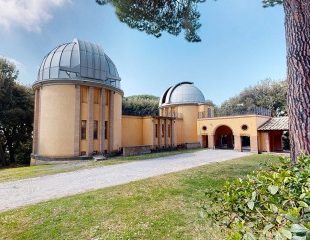
Visits to the Pope’s astronomical observatory at Castel Gandolfo are underway
The Specola Vaticana is “on display”
From 3 August, the Pope’s astronomical observatory in Castel Gandolfo reopens to the public.
The Vatican Observatory (Specola Vaticana) – one of the world’s most ancient active astronomical observatories – is made available to receive visitors and tourists, thanks to a renewed and rich offering of guided tours, developed in collaboration with the Vatican Museums. The spaces of the Pontifical Villas – of which the Gardens and Apostolic Palace can already be visited – will become even more accessible and user-friendly, integrating and extending the tour routes to the museum spaces of the Vatican Observatory’s Visitor Centre and its evocative Barberini Domes, home to the historic Schmidt and Carte du Ciel telescopes; the latter recently restored and now in function.
Experienced astronomy lecturers, selected and trained by the scholars of the Vatican Observatory, will guide participants through ancient and modern astronomical instruments, themed works of art, and precious samples of meteorites. Numerous blow-ups on the walls testify to the Popes' passage through the Observatory. A striking photograph taken on 20 July 1969 shows Pope Paul VI looking at the moon through a telescope a few hours before the Apollo 11 moon landing. Another shot shows the Pope giving a message of blessing to the astronauts. Another image recalls the visit of Pope Benedict XVI holding - wrapped in a handkerchief - a meteorite of Nakhla, named after the Egyptian locality where it was found in 1911, which is thought to have come from Mars. The highlight of the tour will be the final visit to the historic telescopes installed in the two majestic Barberini Domes, which can still be opened and rotated to “see again the stars”. Visits including astronomical observations with the 1891 Carte du Ciel telescope are also planned to take place close to the first quarter of the moon.
The Specola Vaticana is a scientific research institute directly dependent on the Holy See. Its origins date back to the end of the sixteenth century, when in 1578 Pope Gregory XIII established a commission in which a prominent role was held by Fr. Cristoforo Clavio S.J., Jesuit astronomer and mathematician of the Roman College, to prepare the reform from the Julian to the Gregorian calendar, promulgated in 1582. The Observatory operated in the Vatican for just over 40 years, but in the early 1930s, the increase in electric lights together with the urban growth of the capital made the sky in Rome so bright that astronomers were unable to study the faintest stars. For this reason, Pius XI ordered the Observatory to move to his summer residence at Castel Gandolfo. In 1981 a second research centre was founded in Tucson, Arizona, the “Vatican Observatory Research Group”, and in 1993 the Vatican Observatory, in collaboration with the Steward Observatory, completed the construction of the Vatican Advanced Technology Telescope (VATT) on Mount Graham (Arizona). Today, the Vatican Observatory collaborates with many international astronomical institutes and is a member of the International Astronomical Union (IAU) and the International Centre for Relativistic Astrophysics (ICRA). Since 1986, it has been organizing a summer school of astronomy in Castel Gandolfo.









